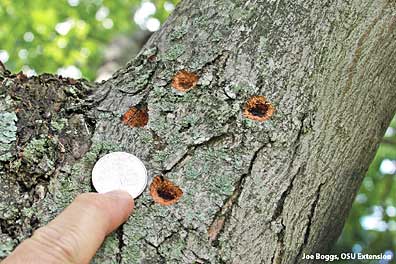

“One of the biggest things is not to move firewood,” Dr. Phillip Baldauf, Asian longhorned beetle eradication project manager for Ohio, said.
Baldauf said the two satellite infestations they have found so far, one in Monroe Township last year and one in Stonelick Township last month, were both because of the movement of infested firewood.
“If we can minimize that then we can just deal with the natural movement of the beetle,” Baldauf said. “Once people start assisting with the movement of the beetle it can end up anywhere.”
Rhonda Santos, public information officer for USDA-APHIS, said infested wood could have been moved before regulations were put in place last year, so it is likely that there could be other satellite areas of infestation in the area.
“I think we are going to discover more infested trees until every host tree has been surveyed,” she said.
Santos said they saw the first satellite infestation early on in Monroe Township and now also with Stonelick Township.
“It’s possible that something may show on their trees now,” Santos said. “People need to remain diligent in looking at trees and reporting what they may find.”
Baldauf said some of the most noticeable signs of the Asian longhorned beetle are exit holes, egg sites, or signs of chewing on the tree, and also the adult beetle.
“When the larvae mature into adults they leave almost a perfect circular exit hole,” Baldauf said. “It is about the size of a dime and you could easily stick a pencil in there.”
Baldauf said this is one of the easiest signs of Asian longhorned beetle infestation to recognize.
He said another sign is chew holes from adult females preparing to lay their eggs.
“This is also what we look for,” Baldauf said. “A lot of times it looks like normal cracking in the bark surface.”
Baldauf said residents can look for adult beetles as well. He said Asian longhorned beetles are shiny black beetles with white speckles and antennae, and they can be anywhere from an inch to an inch and a half long.
“When they first emerge they have a tinge of blue,” Baldauf said.
The month of August is the most likely time of year to see adult beetles.
Baldauf encouraged residents to inspect their trees even if they do not live close to the infested area.
Host trees for the Asian longhorned beetle include maples, birches, elms, poplars, ash trees and more.
“If they care about the health of their trees or trees in the vicinity of where they live they should look at their trees,” Baldauf said. “And if they do find something suspicious, give us a call.”
Baldauf said he would much rather have residents call and be wrong about an infestation than not call and be right.
In addition to residents looking at their trees, officials with the Ohio State University Extension Office are also encouraging professionals in the industry to be aware of the signs of an Asian longhorned beetle infestation.
Joe Boggs, assistant professor for the Ohio State University Extension, said they are working to train professionals in the industry how to recognize signs of infestation.
“We want to make sure the people who make a living with trees are definitely aware,” Boggs said.
Boggs said this is important because these professionals work outside around trees on a daily basis. He said they are also looking at putting together educational programs for master gardeners and members of the public as well.
For more information about the Asian longhorned beetle visit www.beetlebusters.info. To report any suspicious damage or findings contact the local Asian Longhorned Beetle Eradication Program at (513) 381-7180.
